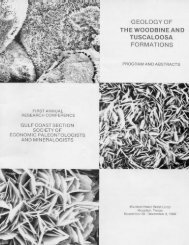Petroleum Systems of Deep-Water Basins - Gulf Coast Section SEPM
Petroleum Systems of Deep-Water Basins - Gulf Coast Section SEPM
Petroleum Systems of Deep-Water Basins - Gulf Coast Section SEPM
Create successful ePaper yourself
Turn your PDF publications into a flip-book with our unique Google optimized e-Paper software.
Obstacle and Sinks: Effects on Turbidite Flow on<br />
<strong>Deep</strong>water Continental Margins<br />
Dave Waltham<br />
Department <strong>of</strong> Geology<br />
Royal Holloway<br />
University <strong>of</strong> London<br />
Egham, Surrey TW20 OEX<br />
United Kingdom<br />
e-mail: d.waltham@gl.rhul.ac.uk<br />
Ian Davison<br />
Earthmoves Ltd.<br />
8 Cabrera Avenue<br />
Virginia <strong>Water</strong>, Surrey GU25 4EZ<br />
United Kingdom<br />
e-mail: i.davison@earthmoves.co.uk<br />
Abstract<br />
Numerical models are used to investigate the effects <strong>of</strong> bathymetric obstacles and sinks on turbidite flow and sediment<br />
deposition. Modeling results suggest that bathymetric obstructions such as salt domes produce a thick<br />
sedimentary apron on the landward side <strong>of</strong> the dome and a heart-shaped thin area over the dome crest. The maximum<br />
thickness <strong>of</strong> sediment is located where the flow impinges on the dome. Seaward-dipping fault scarps accelerate flow<br />
and produce local elongate depocenters both landward and seaward <strong>of</strong> the fault scarp. The depocenter is located seaward<br />
<strong>of</strong> the scarp as flow accelerates over the scarp, and there is no deposition immediately in the hanging wall.<br />
Counter-regional faults are very effective barriers to sedimentation and produce an elongate depocenter in the hanging<br />
wall <strong>of</strong> the fault. Oblique counter-regional faults produce an asymmetric depocenter, in which the thickest<br />
sediment is located in the opposite direction to the flow deflection. Depressions caused by salt withdrawal are the<br />
most effective sediment traps and produce depocenters twice the thickness <strong>of</strong> those produced by fault scarps or salt<br />
domes.<br />
35

















